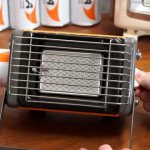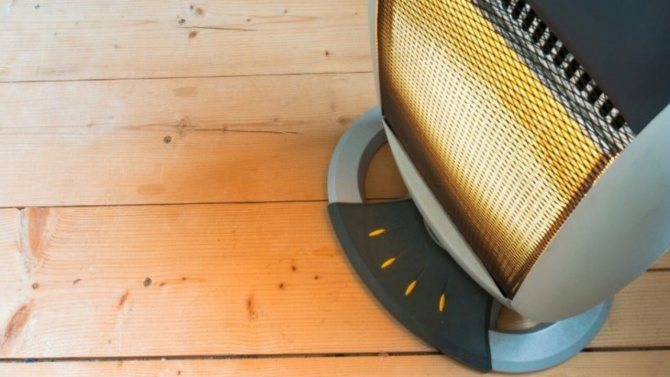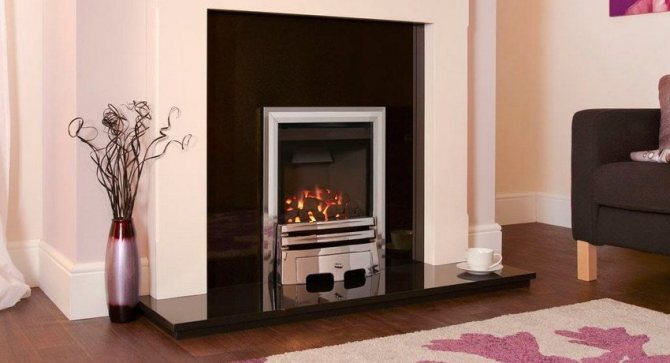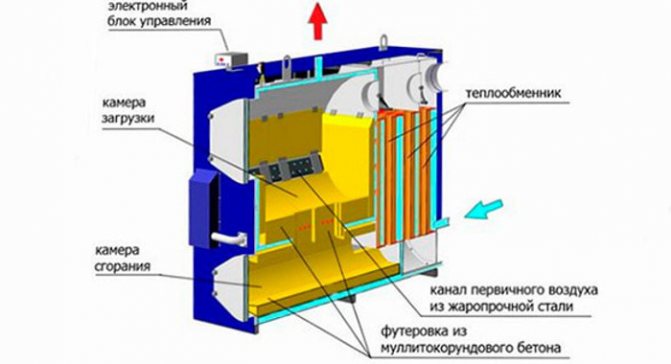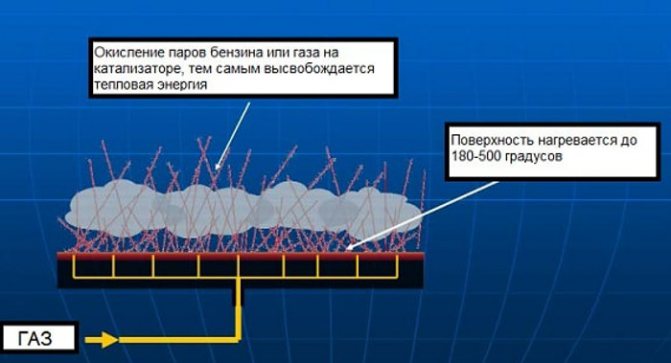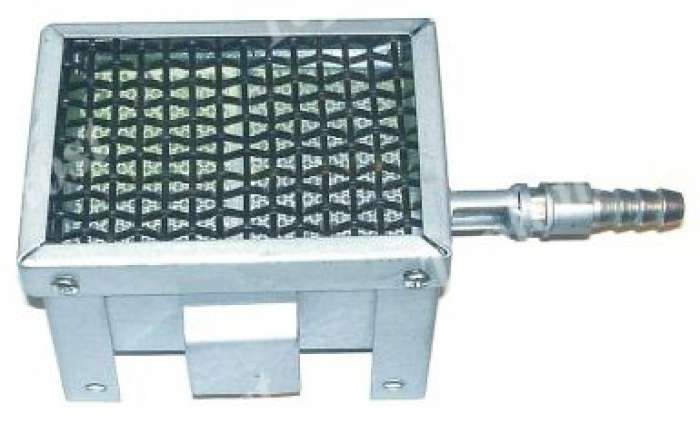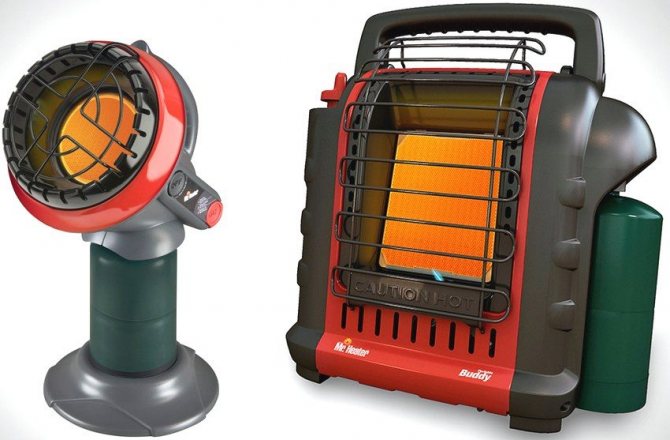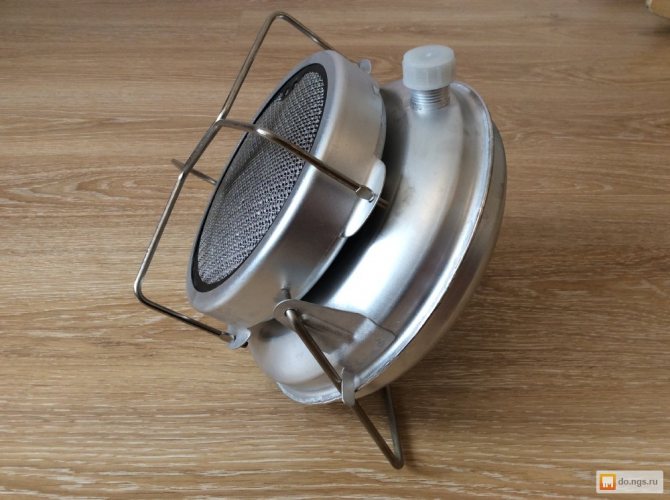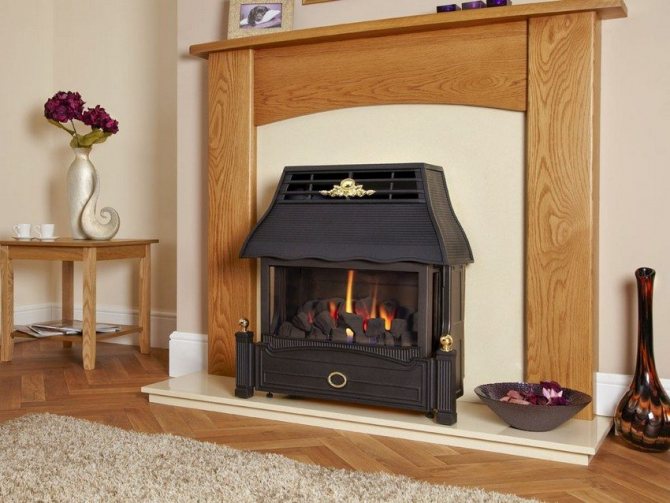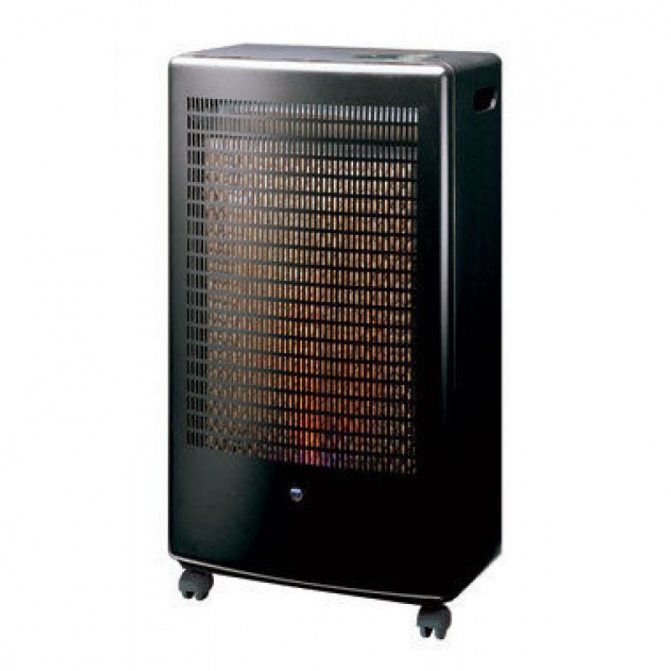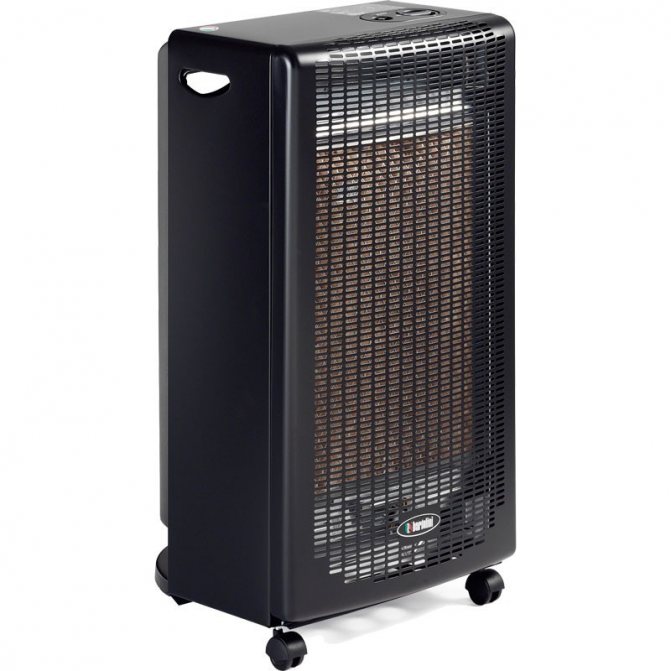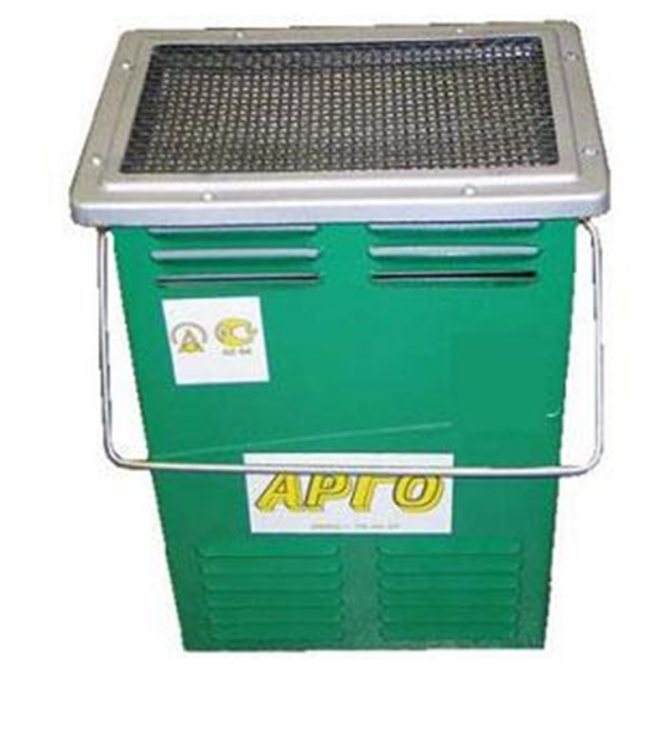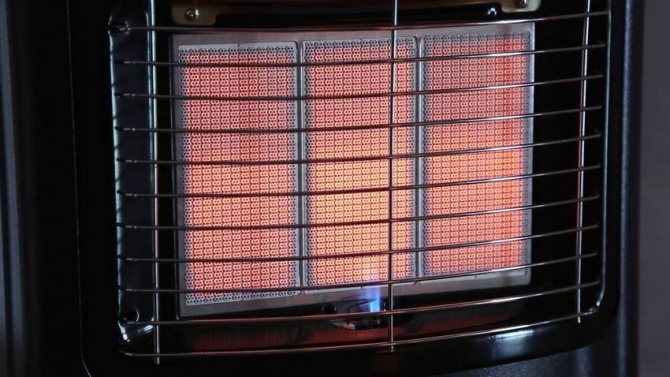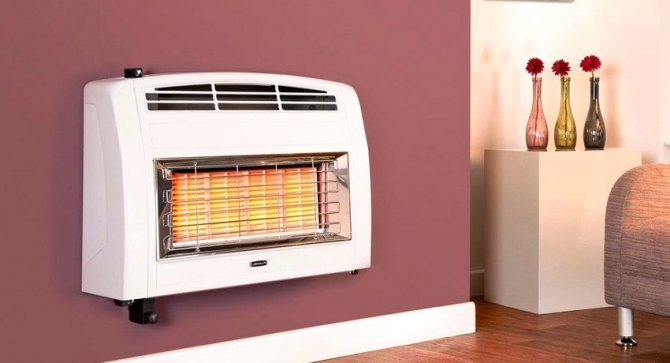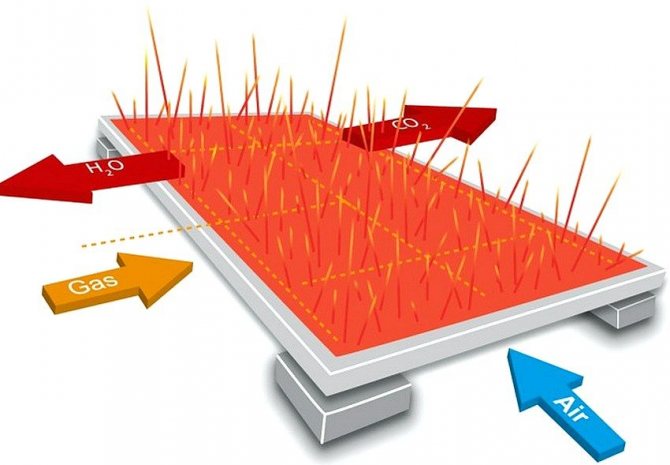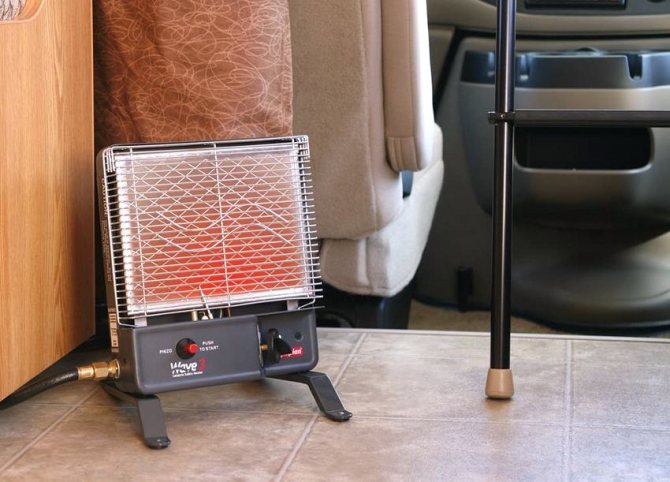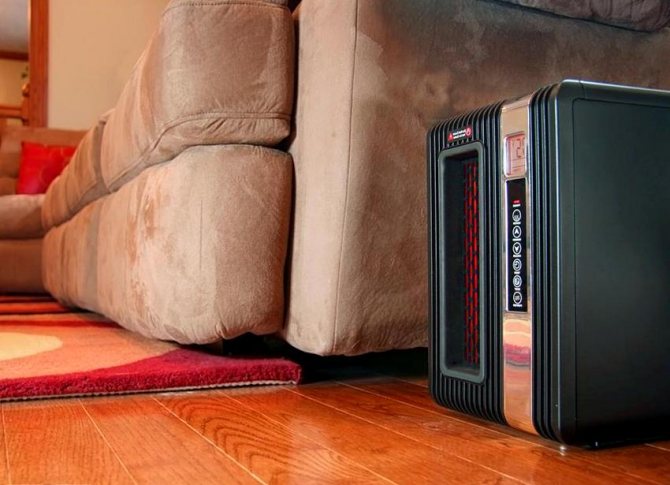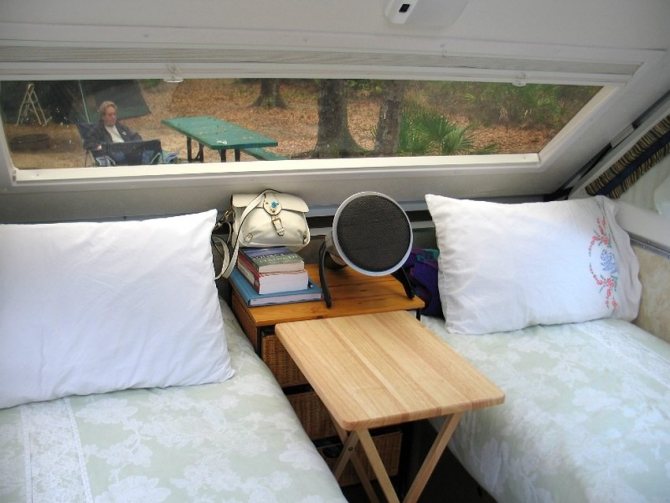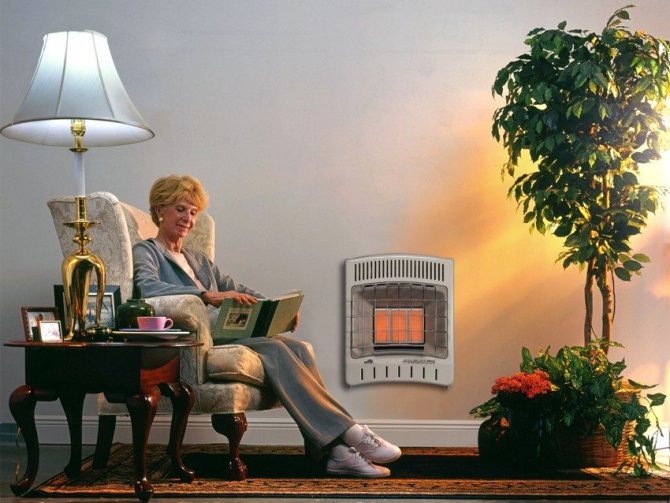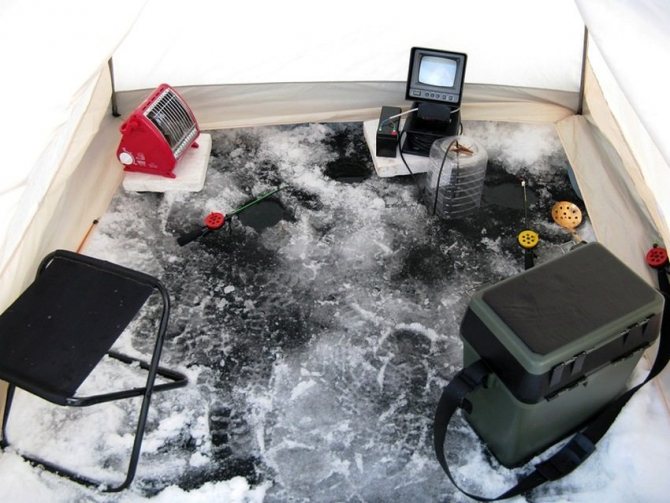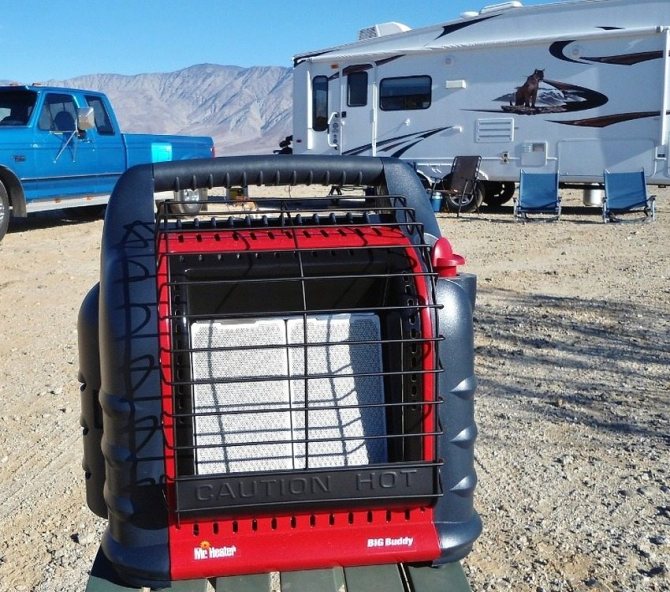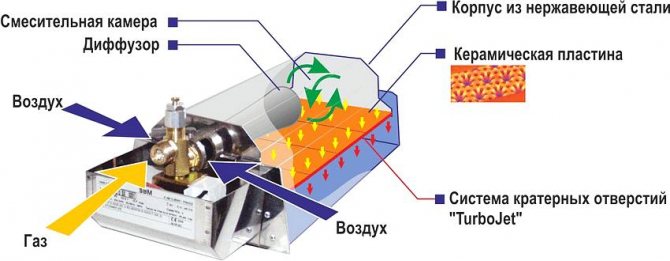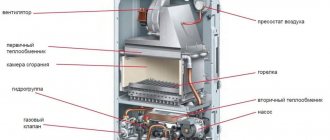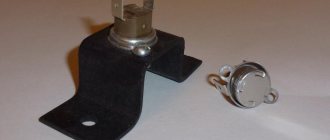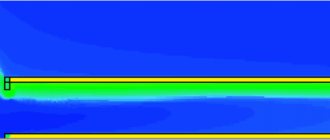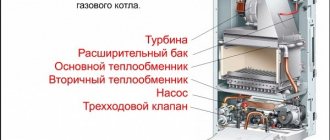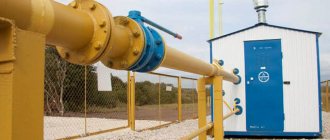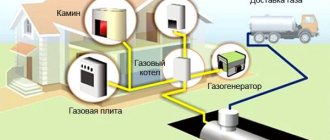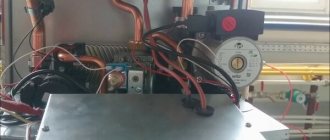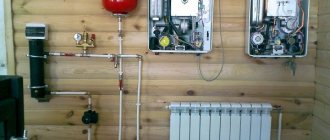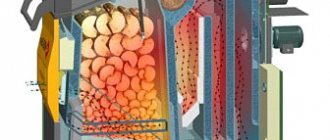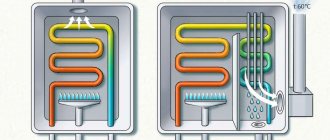What it consists of, how it works
The heating unit works on the principle of heat energy release. The upper part of the heater plate is covered with holes through which warm air enters. Glass fiber coated with platinum powder is located under the plate. The oxidation process of fuel vapors, regardless of the fuel (gas, gasoline), heats the air.
The fuel is burned on the surface. The device is safe, unlike open flame heaters.
The heating process is economical, a minimum of fuel is consumed. The smell of combustion products is not emitted.
Despite the safety, low emission of exhaust gases, the catalytic air heater must be installed in a ventilated area. There should be at least two ventilation holes, they should be located opposite.
The shelf life is 8 years. When the equipment breaks down, the plate can be replaced at service centers.
The apparatus consists of:
- plates are the main piece of equipment. Some models are equipped with a tubular heater to provide additional heat;
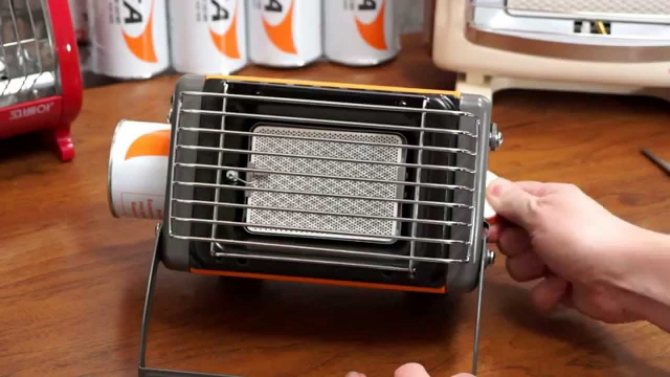
Heating plate
- control panel for turning on and off the device, setting the required heating temperature;
- housing, inside of which there is a container for loading fuel. There are models in which there is no case. Suitable for travel.
Additional items include:
- a fan to distribute air around the room;
- a thermal fan to increase the heating power of the equipment;
- horizontal sensor that reacts to sudden impacts on the device, incorrect location of the heater. If failures are detected, the sensor turns off the device;
- flame control sensor. If the flame is above normal, the gas heater will automatically shut off;
- carbon dioxide level control sensor. If a failure occurs, the level of concentration of combustion products has increased - the sensor automatically turns off the heater.
Combustion principle
The mechanism of work consists in combining two reacting substances that react. Due to the combination of elements, the combustion product is oxidized, transferring heat to the plate, heated air enters the room.
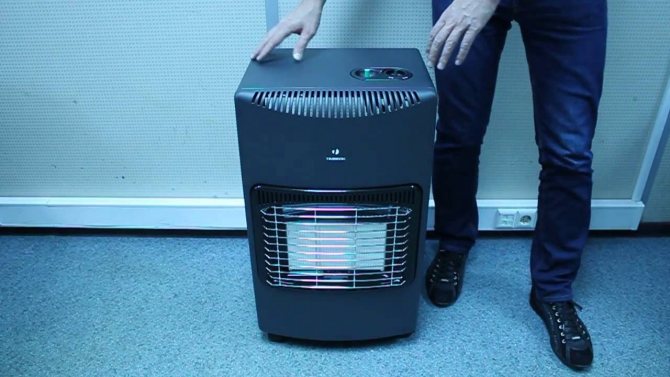

Combustion principle
Having entered into a reaction, the supply of heat is activated. The following combustion products are combined with active ones. The cycle is continuous, ensures uninterrupted heating of the air.
How to choose an IR ceramic gas heater
Popular brands of gas-ceramic emitters
Influence on human well-being
There is a health hazard, but it is not associated with the infrared radiation used, but with the combustion of gas. During the combustion process, a certain amount of carbon dioxide is released, which leads to headaches and can cause poisoning.
In fairness, it is worth noting that the harm is mainly associated with improper operation of the device and violation of some recommendations:
- Continuous heating time should not exceed 12 hours. During the heating process, it is important to ensure an adequate supply of fresh air into the room.
- The first start-up is best done in the presence of a specialist. This is especially true when the emitter is connected to the main gas.
- The working temperature of the heating panel is 900 ° C. It is necessary to protect the device from accidental contact of people (especially children) to the heating element.
Infrared radiation has a beneficial effect on human health. But when choosing a gas emitter, it is necessary to take into account the harm from gas combustion.
Common designs
There are several options for catalytic apparatus. Some are connected to a gas cylinder, others to a centralized gas supply. Differ in design:
- monolithic. The tank with fuel is placed in the box of the device - a closed design. The balloon volume of standard models is 27 cubic meters.
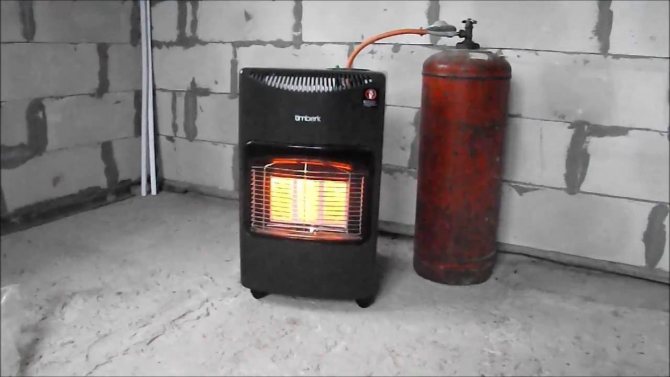

Monolithic heater
- without housing. Consists of a plate impregnated with a substance, a cover with holes. Suitable for tourists, you can heat tents, cars.
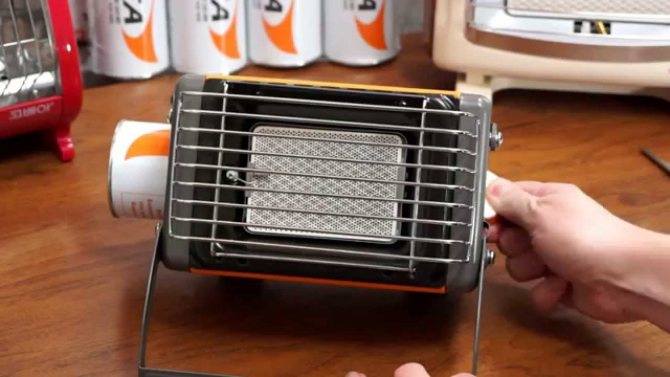

Heating for tourists
The device without a case is compact, not suitable for an apartment, a house, and is intended for heating the air in small rooms.
Varieties
All catalytic heaters are primarily distinguished by their design features. The most widespread are monolithic devices. In them, a bottle for liquefied gas is located directly inside the body. Depending on the model, the volume of this container can be no more than 27 cubic meters.
In other types of designs, the presence of a housing is not provided. They only have a catalyst-impregnated plate. These models are often used during travel and camping trips to heat cars and tents. They are compact and easy to take with you.
In addition, the devices differ in the type of heating: they can be ordinary or infrared. Infrared gas appliances use a ceramic panel for heating. For more efficient and quick heating, to achieve a comfortable temperature in the room, special reflective plates are installed inside the devices.
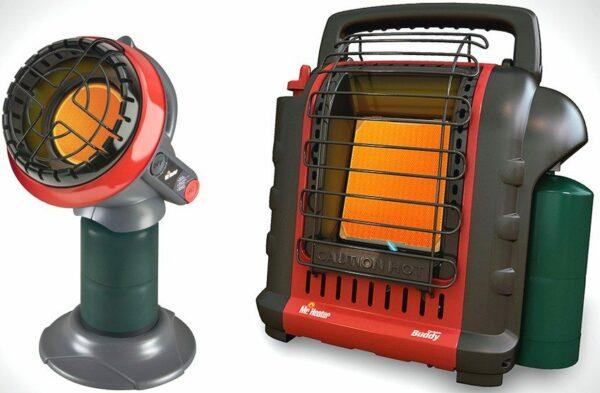

Equipment types
Views:
- a conventional heater with a catalytic panel. Works according to the standard scheme. There are different designs. There are massive models that resemble a boiler, there are miniature models that are easy to carry due to their low weight;
It is necessary to select a gas heating device, taking into account the area of the room. The larger the room, the more powerful the equipment should be.
- infrared gas catalytic unit. Ceramic panel construction. The inner side is equipped with a reflector from the inside, heat is distributed throughout the room. The units provide heating without wasting a lot of resources.
Infrared heater is not recommended for use in small rooms. The area of the heated space must be at least 10 square meters. Suitable for heating the air in open spaces, for example, verandas, gazebos.
Gas type of fuel is in demand. When the heater is operating, a propane-butane mixture is burned, warm air enters the room. Most often, a gas heater is used to heat summer cottages and garages.
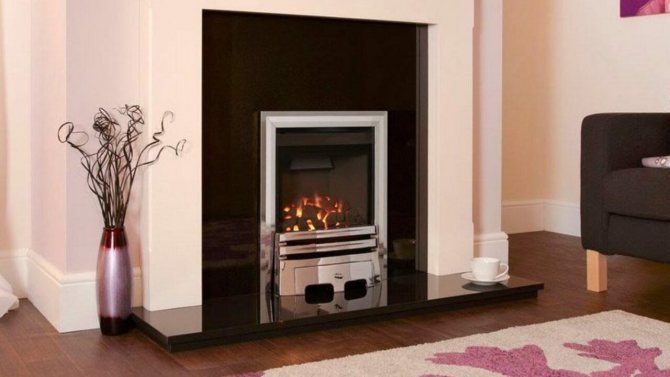

Gas heating
Heating devices operating from bottled, centralized gas in full serviceability do not emit harmful combustion products into the air. However, it should not be installed in rooms less than 20 square meters.
Differences from gasoline, multi-fuel models
More often, the owners of apartments and houses choose gas to heat the catalyst. Other types of catalytic air heaters:
- gasoline devices. The design has a built-in fuel tank connected to the catalytic cartridge. Oxidation of gasoline vapors, after entering the cartridge, provides heating. Catalytic heaters are compact, lightweight, popular with tourists, fishermen;
- technical alcohol is a type of fuel for the operation of a catalytic heating device. Inside the structure there is a compartment into which alcohol and dry fuel are poured. Designed for field conditions, not used in homes. Due to its compactness, weight no more than two kilograms, the catalyst is convenient for hiking, traveling;
- multi-fuel heaters are versatile. You can connect a gas cylinder, fill up with gasoline, fill up with dry fuel. However, they have a low power level.
Each of the heating devices has an external difference from the gas one. There are no other noticeable differences. Each unit works according to the same principle and has a similar structure.
Gas-fired heating appliances are simple. Gasoline is more difficult. It is necessary to use high quality, refined raw materials.
Advantages, disadvantages of catalytic heaters
Benefits:
- The catalytic heater does not release harmful substances into the air during operation. The microclimate of the room is not disturbed, does not affect the balance of oxygen and carbon dioxide;
Catalytic heaters are safe and environmentally friendly.
- the device is safer than analogs operating on gas. The danger of fire, emission of harmful carbon monoxide gas is practically zero;
- regulation of heating temperature;
- compactness allows you to move the catalytic gas unit around the rooms, take on trips.
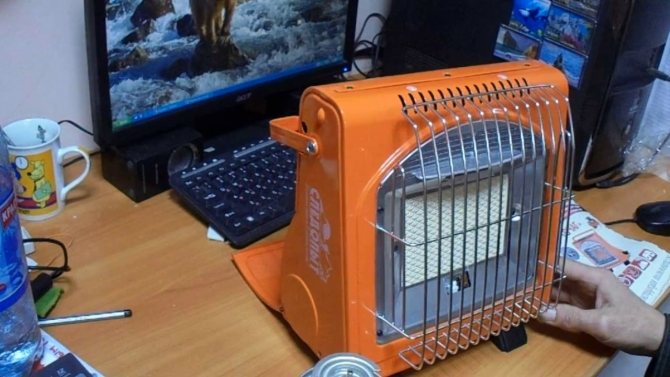

Portable heater
Disadvantages:
- a short operating period is associated with the burnout of the catalyst, which must be periodically changed. The cost of replacing a spare part is 2/3 of the price of the equipment. It is easier to purchase a new catalytic heater than to change parts;
- you must use highly purified fuel, otherwise the device will break.
Review of the best manufacturers
Although the selection of catalytic models is currently quite large, in order not to be mistaken, it is better to choose devices from the best manufacturers.
Bartolini
The company produces some of the most reliable and high quality devices. They run on liquefied gas and boast high power - in some models it reaches 4200 watts. Also, one of the main advantages of Bartolini devices is their independence from the availability of communications.
Most models are equipped with a gas cylinder built into the body. The devices have several power levels that you can adjust yourself. Depending on the model and configuration option, Italian heaters can cost from 11 to 18 thousand rubles. In addition, Bartolini heaters have a high degree of safety. Most of them are equipped with a carbon dioxide monitoring sensor and an automatic roll-over shutdown system. The most popular model is the Bartolini pullover k.
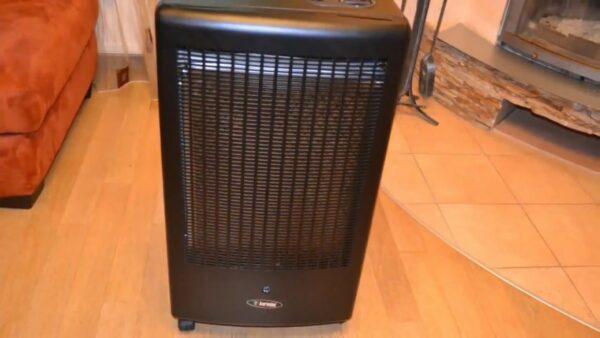

Campingaz
The French company is known for its economical and compact heaters. It manufactures equipment for use in residential, industrial and warehouse environments, as well as portable models. The devices are economical in fuel consumption and cost around 10,000 rubles. The most popular model is the Campingaz cr 5000 turbo.
Kovea
The Korean firm is known for its portable infrared models. Equipment safety is achieved by almost complete rejection of the use of plastic parts. On average, Kovea heaters cost 5-11 thousand rubles.
Choice
Should be considered:
- the size of the room to be heated;
- the frequency of using the heater;
- what is the maximum amount that can be spent on equipment;
- it is worth understanding which heater model to consider;
- determine the required power of the device for a specific room;
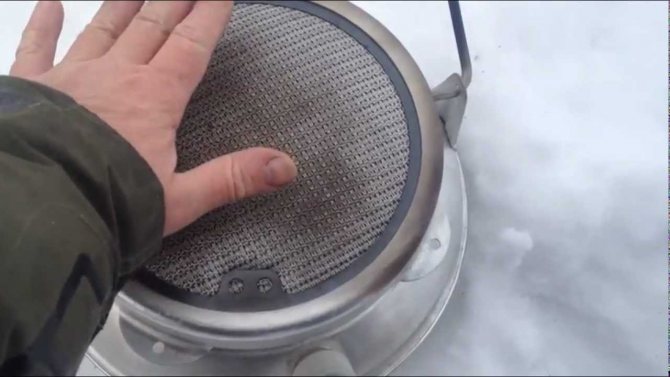

Warming device
Popular models
Manufacturers:
- gas heater Bartolini. Units are produced in Italy. High power devices. The manufacturer made the main emphasis on the lack of connection of the device to communications. Bartolini catalytic heaters work independently of the connection with additional heating devices.
- Campingaz company puts maximum emphasis on heaters for recreation.
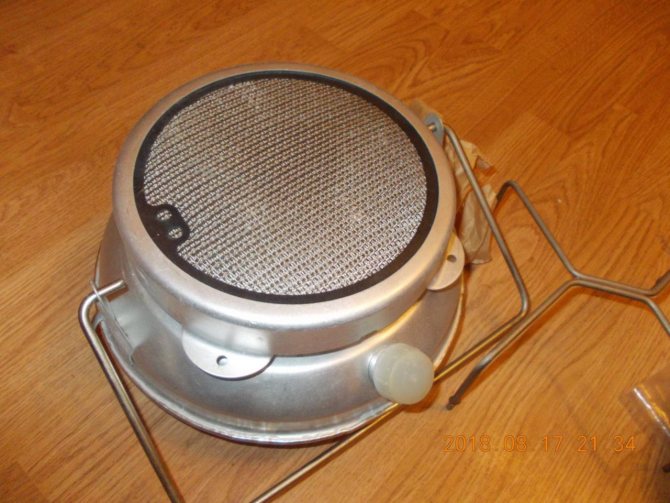

Popular models
- Kovea is also in the top three in popularity and high quality. In addition to apparatuses, Kovea offers high quality refined fuels.
Areas of use
Catalytic air heaters are rarely used for heating residential premises. Unless we are talking about an unfinished private house where repairs are being made, or people have already moved, and the main heating system has not yet been installed. In this case, the device will become a real salvation. However, there are more common uses:
- Garages. The heater is able to warm up the area of a standard garage, and work without fire makes it safe to use it near cars.
- Small workshops. The catalytic heating method is a real salvation for workers in various workshops. There are fire safety rules, but heating systems are usually absent.
- Tents. A catalytic tent heater will provide warmth for tourists who like to spend the night in nature. The marching version weighs a little, and warms an area of about 20 sq. M.
- Greenhouses. Perfectly replaces stoves, now gardeners can not wake up at night to put firewood: the crop is under reliable protection.
- Tempest. In such buildings, this is the only safe way to keep warm.

